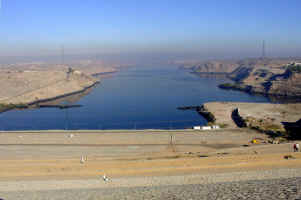
It seems all together backwards: Upper Egypt is in the south and Lower Egypt is in the north. It has nothing to do with the map, rather the direction the Nile flows. The Nile flows from south to north, so the Nile delta is called "lower" Egypt. The Nile's origin is called "upper" Egypt. In the times of the pharaohs, the Nile would flood every year. The flood, or inundation, washed nutrient rich silt from the Nubian south that fertilized farm lands along the banks. The inundation was central to Egyptian culture. When fields flooded, farmers became an available work force for projects like the Pyramids.
Now-a-days, the inundation is extinct. The High Dam at Aswan blocks the flooding in favor of a more constant depth and hydro-electricity for our energy hungry modern world. The dam is considered one of the modern wonders of the world. However, progress came at a cost. The environmental impact was huge. Without the rich nutrients from the inundation, farmers must now use tons of fertilizer. The fishery in the Nile delta and Mediterranean was decimated when the historical purging was blocked. Worse yet, fertilizer run-off pollutes ground water and encourages the growth of pathogenic parasites in the stagnant standing water.
The picture above is a view from the high dam looking north towards the Cairo. The original Aswan dam, built by the British at the turn of the century, is barely visible in the foreground. Behind this picture is the massive Lake Nasser that was created when the dam was completed back in 1970 after 18 years of work. Our guide was a little sensitive about us taking pictures. Obviously, the dam is a strategic asset and security risk. The dam's history is mired in juicy politics. The Western World, including the World Bank, Great Britain, and the USA all refused to help fund the project. Nasser, Egypt's President, teamed with the Russians and made big stink by nationalizing the Suez Canal to raise funds.
During the dam's construction, many of Egypt's ancient treasures were threatened by the Nile's rising waters. UNESCO and many supporting countries stepped in to help and relocated many of the treasures to higher ground. Ramses II's temple at Abu Simbel was one of the most famous treasures saved. Back in 1964, the 3000 year old monument was dismantled, raised nearly 200 feet, and reassembled. The picture above is from the Oriental Institute of The University of Chicago collection, and it shows Abu Simbel in 1905, well before the High Dam project flood waters.
Abu Simbel is at the southern reaches of Egypt's historical boundaries in an area known as Nubia. Pharaohs made excursions into Nubia to raid, pillage and conquer, although they always returned to Thebes or Memphis after their lengthy raids. Nubia was the source of much of Egypt's gold. Among other things, Abu Simbel was symbol of the pharaoh's power over the Nubians. Traversing this section of the Nile was difficult. Soldiers had to guide their ancient boats from the banks using long ropes to avoid the cataracts.
The first of the cataracts was near Aswan. Aswan is the home of an ancient granite quarry. Pictured above is Queen Hatshepsut's massive unfinished obelisk at an Aswan quarry. Obelisks look like a tower with a pyramid topping used to adorn rich temples. Many of Egypt's obelisks were moved out of the country during the past hundred years and are located in Rome, Paris, London, and New York. Obelisks were hand chiseled out of the pink granite using hard dolorite balls. The unfinished obelisk was abandoned after it cracked. If it had been completed, it would have weighed 1000 tons; as much as two jumbo jets! Imagine the difficulty moving and erecting such a monster!
After visiting the quarries, we set out to visit Philae Temple via a small boat. Again, the temple was salvaged from the rising waters of the Nile when the High Dam was built. ts original home was on the island where the ancient Egyptians believed the god Osiris to be buried. Philae is a remarkably well preserved temple. While the temple was built over a period of 800 years, a large portion of the construction took place during the Roman period. The temple was originally dedicated to the goddess Isis, but later had a Christian temple.
Following our first temple visitation, we took a relaxing ride on a felucca. A felucca is essentially an narrow sailboat found all along the Nile in vast numbers. We enjoyed the nice breeze and the scenery of the Aswan area and Elizabeth was so overcome by the relaxing nature of the jaunt that she felt compelled to take a brief nap.